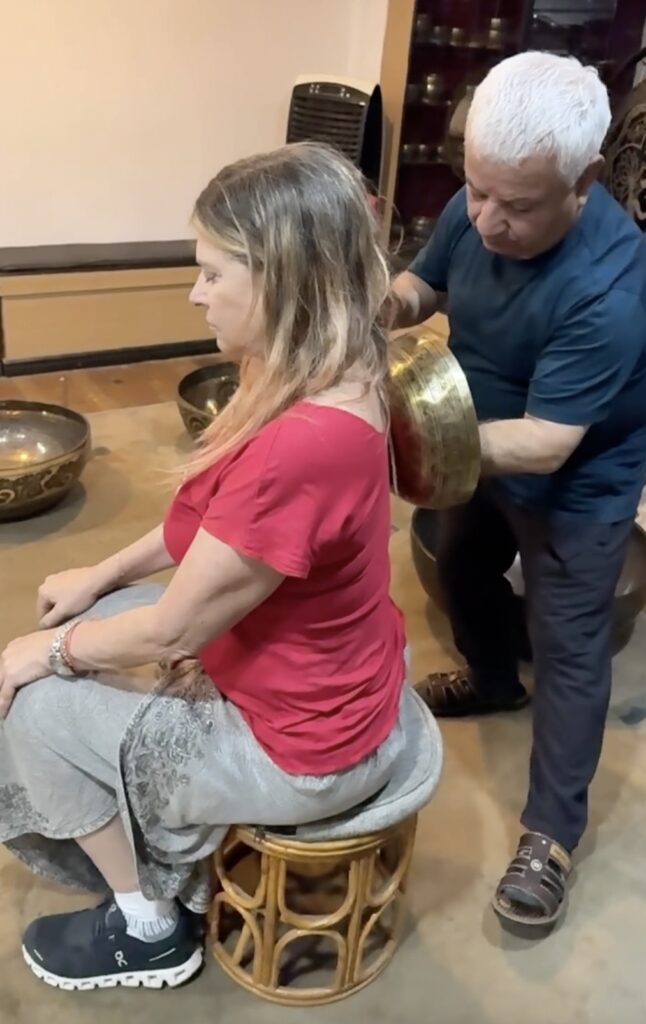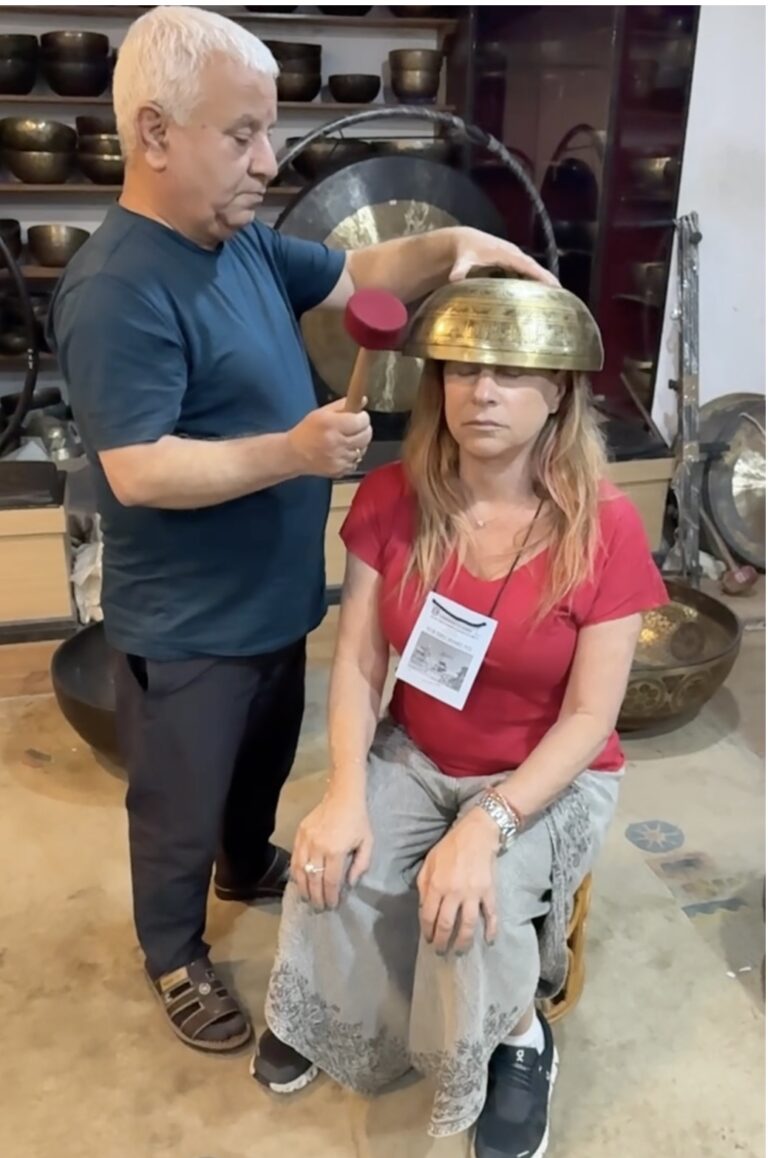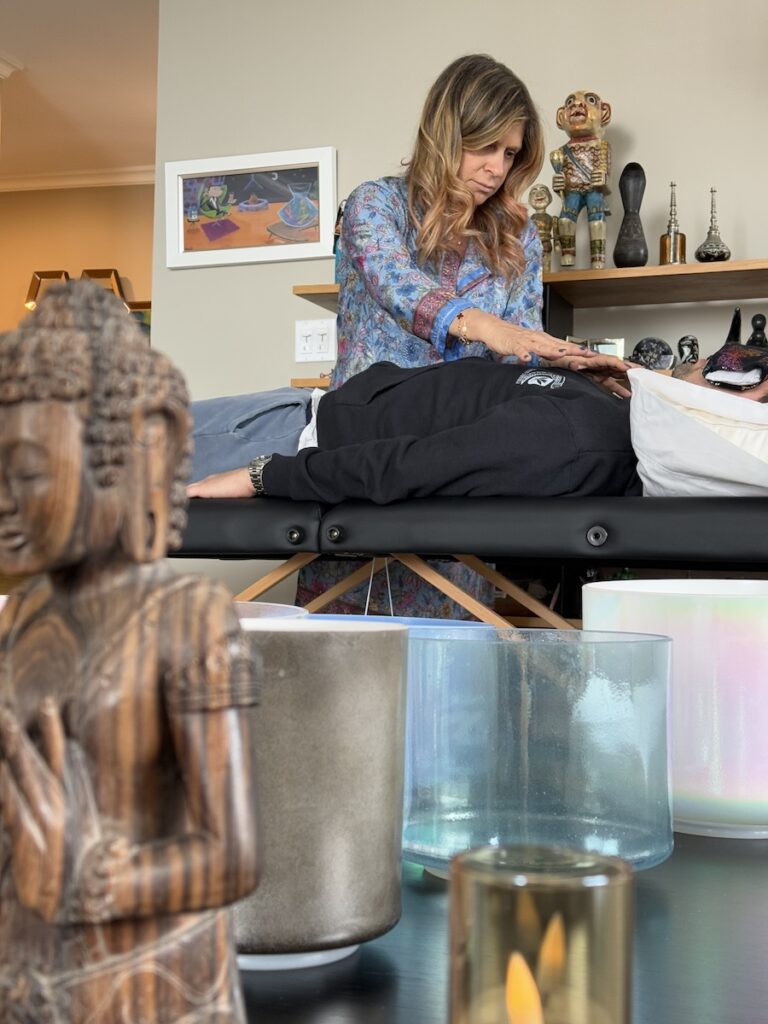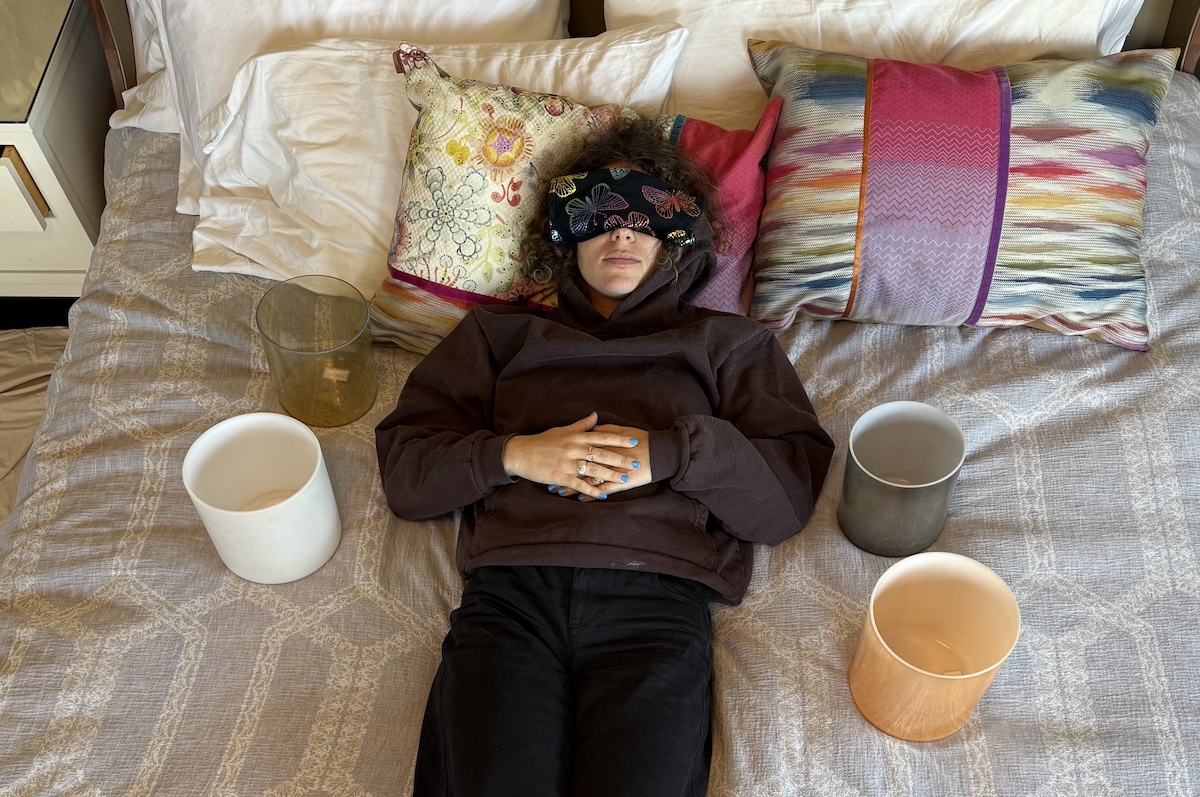Chronic pain is a condition that is near and dear to my heart. My mother suffered from chronic pain for over 50 years with Interstitial Cystitis (IC) and other autoimmune diseases. As a family, we tried every means to alleviate her chronic pain. Ultimately, she took her own life, as she could no longer bear the constant pain, fatigue, and depression she endured.

I have several friends who suffer daily from chronic pain – migraines, auto-immune diseases, IBS and leaky gut, knee and back pain, to name a few. I have expanded my practice to help clients who suffer from chronic pain – while I cannot cure them, I can use alternative therapies like sound therapy, mindfulness meditation, and reiki to give them a much better quality of life.
What Causes Chronic Pain?
Chronic pain is draining and debilitating, making it very difficult to navigate daily life. It can dominate your attention, drain your energy, and restrict your ability to do many of the things you love. Such pain can occur because there is an injury or disease in the body that needs attention. The best solution is obviously to find the cause of the disease or injury and treat it, if possible. But pain can become chronic for another reason. Chronic pain specialists, ask the question, “Why does the pain continue long after the injury has healed?”
The answer seems to lie in the fact that all our body parts are constantly sending signals to the brain along our nerve pathways. However, when a body part, say a foot, is injured, that foot stops sending those messages that were letting the brain know, “Yes, I’m here, I have five toes, I’m bearing weight, I’m OK” etc.
When those familiar messages cease, the brain assumes the foot has been injured or there is something wrong, so it creates another signal, a distress signal, called “pain.” In the healing process, if the foot does not regain full function, if there is scarring, or nerves have been severed, or the nerves in the pain system are also injured, the normal signals never resume, so it is possible that the pain signal will continue on and on.
Chronic Pain and Neuroplasticity
Chronic pain can also be due to neuroplasticity. This means the brain has changed its structure and its way of communicating pain messages, so these messages have become continuous, even after the injury has healed. However, neuroplasticity (the ability of the brain to change) can also lead to the healing from chronic pain.
How Is Chronic Pain Defined?
Chronic pain is pain that lasts for over three months. You may feel the pain all the time or it may come and go. It can happen anywhere in your body and has countless causes.
Chronic pain is a very common condition and one of the most common reasons why people seek medical care. In 2021, about 20.9% of U.S. adults (51.6 million people) experienced chronic pain, according to a study from the U.S. Centers for Disease Control and Prevention (CDC).
Pain is your body’s way of telling you that something’s wrong, like an alarm. But when that alarm continues to go off for months or years, it can drown out many aspects of life that bring you joy. And it can take quite a toll on your physical, mental and emotional health. Because of this, it’s essential to seek help for chronic pain.
Types of Chronic Pain
Chronic pain can come in many different forms and occur across your body. It’s the main symptom of a wide range of injuries, infections and diseases. Common types of chronic pain include:
- Arthritis or joint pain, like knee pain
- Back pain, especially lower back pain
- Cancer pain
- Fibromyalgia
- Headaches, including migraines
- Neck pain
- Neuropathic (nerve) pain
More Traditional Treatments for Chronic Pain
- Lifestyle changes, like weight management, stress management and physical activity
- Physical therapy, and occupational therapy
- Psychological therapies for pain, which can include cognitive behavioral therapy, group therapy acceptance and commitment therapy, mindfulness therapy, and more
- Complementary medicine therapies, like massage therapy, biofeedback, and meditation
- Medical procedures and devices, like surgery, TENS, steroid injections, and botulinum toxin (Botox®) injections
- Clinical Trials
A Pioneer in Treating Chronic Pain
Nicole Sachs, LCSW is a psychotherapist renowned for her work as a pioneer in treating chronic pain through the lens of mind-body medicine, particularly focusing on Tension Myositis Syndrome (TMS). TMS, also known as MindBody Syndrome or neuroplastic pain, is a is a theory proposed by Dr. John Sarno, suggesting that chronic pain can be caused or worsened by emotional stress and psychological factors, rather than solely physical structural problems. TMS has gained attention for its emphasis on the mind-body connection in pain experiences.
Key aspects of TMS
Psychogenic Pain
TMS posits that chronic pain can be a result of emotional conflicts and unconscious psychological factors, not just physical injuries.
Mind-Body Connection
The theory emphasizes how the mind can influence physical sensations and symptoms, including pain.
In her groundbreaking book Mind Your Body: A Revolutionary Program to Release Chronic Pain and Anxiety, Nicole Sachs stresses that the pain is real—it is not in one’s imagination, nor is it psychosomatic or in a person’s head. She states. “The pain is not in your head but the solution is not in your body.” The patient should seek medical attention—have surgery when necessary and take pharmaceuticals as needed. She uses many examples of people with chronic pain and how practices of a specific type of journaling (“journalspeak”) combined with mediation, can cure chronic pain by releasing stuck emotions and calm the nervous system. She has a simple practice of 20 minutes of targeted journaling combined with living kindness meditation.
She uses examples of how people can have one chronic condition relieved only to have another pain take over. My mother was a perfect example of this. When her IC was in remission, other auto immune disorders would take their place (vulvodynia, Lyme disease, pelvic pain, and so on.)

Alternative Therapies to Help Manage Chronic Pain that I Offer
Sound Therapy
Sound is a direct and easy way to stimulate the brain. It has been observed that this stimulation, which reconnects many parts of the brain, seems to provide the necessary signal so the brain can let go of its repetitive chronic pain signal. Those with chronic pain from old injuries or phantom pain from amputation have sometimes achieved complete relief through Sound Therapy. In addition, Sound Therapy helps to relieve stress and improve sleep, so at the very least makes living with a condition like chronic pain seem more bearable.
Sound healing has been used for centuries with tools like singing bowls and binaural beats to promote relaxation and reduce stress. It helps manage pain by altering brainwave patterns and boosting endorphins, benefiting those with chronic pain. Sound healing has been recognized and employed for thousands of years in cultures worldwide. Sound restores energy, decreases stress, and relaxes listeners’ minds, like how a massage therapist works on muscles.
The Power of Singing Bowls
Singing bowls are valuable instruments in sound therapy. They allow people to relax, improve their mood, and facilitate the expression of emotion and physical recovery due to a more balanced environment. In the Journal of Evidence-Based Integrative Medicine, the researchers discovered that one hour of sound meditation relieved participants’ tension, anger, fatigue, anxiety, and depression. The sounds and vibrations of the singing bowls profoundly affect the mind and spirit. Each bowl, when played, emanates sound vibrations that create relaxation and calmness and thus promote balance within the person.
I use both crystal and Tibetan bowls in my customized sound bath therapy. The crystal singing bowls bring my clients to a relaxed meditative state. The metals bowls can be placed on the parts of the body that are emitting pain, to help relieve targeted pain.


Binaural Beats for Mental State Enhancement
Binaural beats are the process of playing two slightly different pitches simultaneously so that they produce an audible rhythm. The brain enters these programs’ mental modes based on the beats per minute, such as relaxation, meditation, concentration, etc.
Benefits of Sound Therapy
- Deep Relaxation Reduces Muscle Tension
Chronic pain often creates a vicious cycle: pain causes muscles to tense, which causes more pain. The sound frequencies, help guide the body into deep relaxation, helping muscles, fascia, and the nervous system soften and release.
2. Shifts Brainwave States
Sound baths encourage the brain to shift from beta waves (alert, thinking, sometimes stressed) to alpha, theta, or even delta waves. Theta and delta, which are achieved by playing binaural beats are states associated with healing, deep rest, and tissue regeneration. When the brain enters these frequencies, pain perception often decreases. This brainwave entrainment shifts the nervous system out of “fight or flight” mode into “rest and digest” mode, helping the body release tension.
3. Activates the Parasympathetic Nervous System (“Rest and Digest” Mode)
Chronic pain often keeps the body in a sympathetic state (fight, flight, freeze). Sound vibrations stimulate the vagus nerve and activate parasympathetic healing, lowering cortisol, blood pressure, heart rate, and inflammation — all of which can make pain feel less intense. Singing bowls produce vibrational frequencies that stimulate the vagus nerve, which plays a key role in reducing inflammation and pain perception.
4. Distracts and Redirects Attention
Pain demands attention; sound gives the mind something else to focus on. The immersive quality of a sound bath gently redirects focus away from pain, breaking the loop of catastrophizing (where thinking about the pain makes it feel worse). When immersed in sound, the brain focuses on the sensory experience rather than pain. This redirection of attention can lead to a reduction in perceived pain.
5. Emotional Release
Chronic pain isn’t just physical — it’s emotional, too. Certain sound frequencies can help the body and subconscious to safely release stored emotional pain, grief, trauma, and anger that often exacerbate physical symptoms.
6. Cellular Resonance and Vibrational Healing
Some theories (supported by emerging studies) suggest that the vibrations actually “tune” the body’s cells, improving cellular communication, circulation, and energetic flow — which could enhance the body’s own repair mechanisms.
7. Promotes Circulation and Relaxation
Low-frequency sound can create subtle vibrations that stimulate circulation, lymph flow, and tissue healing. Relaxation from sound baths also helps release muscle tension, which can be a big contributor to chronic pain.
8. Encourages Neuroplasticity
Repeated exposure to calming, healing sounds can help the brain rewire its relationship to pain over time. This is especially effective when combined with mindfulness, gratitude, or visualization during the sound session.
Consistency Matters
One session may provide noticeable relief, but regular sound bath practice can create cumulative benefits — including lowered baseline stress levels, better sleep, and more resilience against flare-ups. Additional sessions increase longer term reduction of chronic pain.

How Mindfulness Meditation Helps with Chronic Pain
Meditation has similar healing powers as sound therapy. While it is not as powerful as sound healing, the nice thing about meditation is that this is a practice that you can learn to use on you own and is accessible anytime and anywhere. I offer several mindfulness meditation techniques that can help my clients develop a practice that best suits their needs.
There are countless studies on the effects of mindful mediation and how it can reduce chronic pain. Jon Kabat-Zinn, a pioneer in mindfulness mediation, created a revolutionary program called MBSR designed for learning mindfulness and discovering skillful ways to manage stress. He has expanded his practice of mindfulness for people who suffer from chronic pain and explains it in his 2023 book Mindfulness Meditation for Pain Relief: Practices to Reclaim Your Body and Your Life.
I am not trained in MBSR but offer mindfulness meditation practices through my training in mindfulness meditation. In my two year MMCTP program, I was trained by many of the same people that Kabat-Zinn studied under at the Insight Meditation Society and with Jack Kornfield.
Benefits of Mindfulness Meditation
1. Changes the Brain’s Response to Pain (Neuroplasticity)
Pain is not just physical—it’s also processed in the brain. Chronic pain often involves a cycle where the brain amplifies and maintains pain signals. Meditation reduces activity in areas like the somatosensory cortex (which processes pain) and increases activity in areas like the prefrontal cortex (which regulates attention and emotion). This rewiring of the brain (neuroplasticity) can reduce the brain’s habitual overreaction to pain signals.
2. Reduces Pain Catastrophizing and Stress
People with chronic pain often experience catastrophic thinking (e.g., “This pain will never go away”), which worsens pain. Meditation teaches nonjudgmental awareness—you observe the pain without labeling it as “bad” or letting it spiral emotionally. Mindfulness meditation helps lower stress, which can in turn lower inflammation, lessen muscle tension, and calm the nervous system—all of which reduce pain.
3. Activates the Parasympathetic Nervous System
Meditation promotes the relaxation response, which counters the fight-or-flight response. This lowers heart rate, reduces blood pressure, and slows breathing, creating a calm internal state that helps the body disengage from pain signals.
4. Increases Pain Tolerance and Acceptance
Regular meditation helps people sit with discomfort and experience it with more equanimity. It doesn’t mean the pain vanishes—but the suffering component (emotional reactivity, resistance, fear) decreases. Over time, this raises pain tolerance and helps people reclaim their lives.
5. Builds Resilience and Sense of Control
Chronic pain often makes people feel helpless. Meditation gives back a sense of agency—a tool they can use at any time to calm the mind and body. This can help reduce dependence on medication and increase motivation for other healing activities.
Common Forms of Meditation for Pain Relief
- Mindfulness Meditation – focuses on observing the present moment without judgment.
- Body Scan Meditation – gradually brings awareness to each part of the body, releasing tension and connecting mind and body. I work with my clients to refocus on the part of their bodies that are relaxed and pain-free.
- Loving-Kindness Meditation – fosters compassion, which reduces emotional distress and softens pain perception.
- Breathwork and Visualization – helps calm the nervous system and shift attention away from the pain.

Reiki for Chronic Pain Management
Benefits of Reiki
1. Deep Relaxation and Nervous System Calming
Reiki promotes a state of deep relaxation that can help shift the body from the sympathetic (fight-or-flight) state to the parasympathetic (rest-and-digest) state. This shift:
- Lowers stress hormones like cortisol
- Enhances circulation and lymph flow
2. Energy Blockage Release
From an energetic perspective, Reiki practitioners believe that pain can be caused by blockages or imbalances in the body’s energy (or ki/chi). Reiki works to:
- Clear stagnant or blocked energy
- Balance the flow of life force energy
- Support the free movement of energy through the chakras and meridians
3. Emotional and Mental Relief
Chronic pain often carries an emotional burden—anxiety, frustration, grief, or depression. Reiki can help by:
- Supporting emotional release in a safe, non-verbal way
- Providing a space for feeling nurtured and cared for
- Calming mental chatter, which may reduce the subjective experience of pain
4. Supporting Neuroplasticity and Healing
Reiki doesn’t directly alter neural pathways like some physical therapies do, but by reducing stress and encouraging positive emotional states, it may help:
- Interrupt the cycle of chronic pain signals
- Encourage the body and brain to “reset” pain patterns
- Foster conditions where neuroplasticity (the brain’s ability to rewire) is more likely to occur
See How You Can Benefit from Alternative Therapies to Manage Chronic Pain
Sound Healing, Mindfulness Meditation, and Reiki do not cure pain, but they can help you manage it so you can experience some relief. I practice all these modalities, which I can do in person or virtually. If you are interested in learning more, schedule a complimentary discovery call and start your healing journey.



